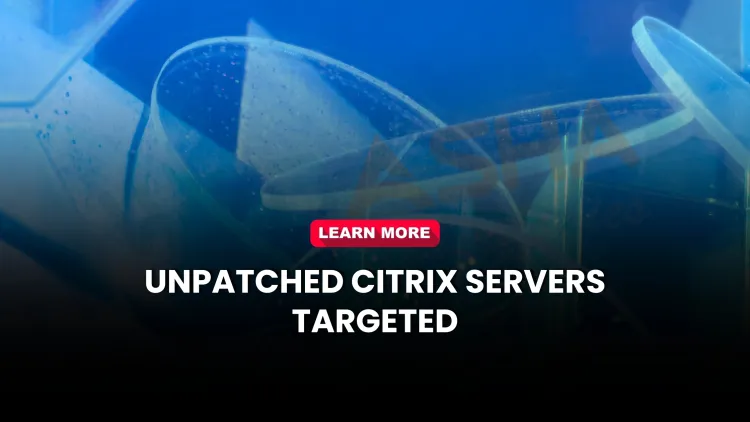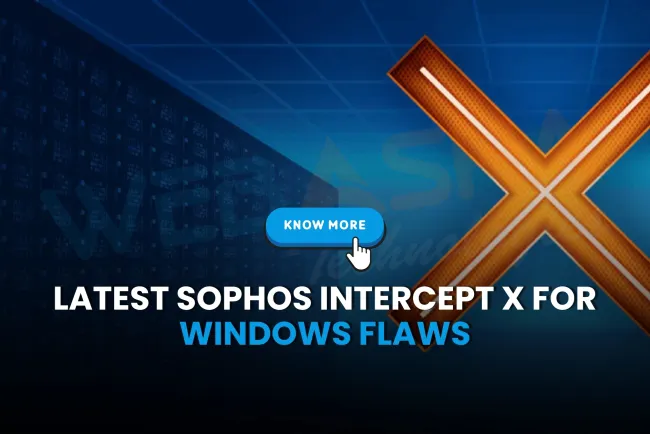Citrix Bleed 2 | 2100+ Unpatched Citrix NetScaler Servers Vulnerable to CVE-2025-5777 Exploit
Over 2,100 Citrix NetScaler servers remain exposed to CVE-2025-5777 (Citrix Bleed 2), allowing attackers to steal session tokens via authentication bypass. Learn how to patch and protect your systems now.

Thousands of Citrix NetScaler servers remain unpatched and vulnerable to a critical security flaw, allowing cyber attackers to bypass authentication mechanisms and steal session tokens. Despite the availability of patches, over 2,100 systems are exposed to active exploitation, posing a serious threat to enterprise infrastructure.
Let’s explore what CVE-2025-5777 (dubbed "Citrix Bleed 2") is, how it works, the risks it introduces, and how organizations can protect themselves.
What Is CVE-2025-5777 (Citrix Bleed 2)?
CVE-2025-5777, known as “Citrix Bleed 2,” is a high-severity vulnerability found in Citrix NetScaler servers. This flaw enables attackers to bypass authentication, reuse sessions, and steal sensitive data without user consent.
-
CVSS Score: 9.2 (Critical)
-
Affected Products: Citrix NetScaler (previously Citrix ADC)
-
Vulnerability Type: Session token theft & authentication bypass
-
Discovery Timeline: Mid-2025, actively exploited by threat actors
Why Is Citrix Bleed 2 Dangerous?
Citrix Bleed 2 is considered a dangerous evolution of the 2023 Citrix Bleed vulnerability, which wreaked havoc across global networks. What makes the 2025 version more potent is:
-
Ability to reuse valid session tokens
-
Exploits unpatched infrastructure easily
-
Combines legitimate traffic patterns with suspicious activity to evade detection
-
Affects public-facing enterprise services
How Many Servers Are at Risk?
As of June 2025, researchers confirmed:
-
2,100+ Citrix NetScaler servers remain unpatched
-
These servers are exposed to active attacks in the wild
-
IP scanning shows vulnerability reuse across multiple geographic regions and industries
What Are the Exploitation Techniques?
Threat actors are using sophisticated methods to exploit the flaw:
-
Capturing session tokens from authenticated users
-
Bypassing two-factor authentication (2FA)
-
Mimicking session reuse from expected IPs
-
Launching multi-vector attacks across unsegmented environments
These attacks often go unnoticed due to the subtlety of session replay techniques combined with legitimate-looking activity.
Which Organizations Are Most at Risk?
Organizations with:
-
Outdated Citrix NetScaler versions
-
Public-facing services (e.g., web portals, load balancers)
-
Weak network segmentation
-
Delayed patching policies
Industries most affected include:
-
Finance and banking
-
Healthcare
-
Government sectors
-
Managed Service Providers (MSPs)
How to Detect If You're Affected
Here are signs your Citrix server might be compromised:
-
Unusual session reuse from strange IPs
-
Sudden logouts or hijacked sessions
-
Abnormal token lifespan in logs
-
Presence of unexpected admin logins or 2FA bypass attempts
Use traffic analyzers and endpoint detection tools to flag abnormal session patterns.
Mitigation and Patch Guidance
Citrix has already released security patches addressing CVE-2025-5777. Here’s what to do:
-
Update NetScaler immediately to the latest patched version
-
Revoke all session tokens across infrastructure
-
Rotate API keys and admin credentials
-
Enable MFA (Multi-Factor Authentication) across all user accounts
-
Monitor logs for signs of compromise (IoCs provided by Citrix)
-
Segment your network to isolate Citrix appliances from critical services
Lessons from Citrix Bleed 2
This incident is a wake-up call for all enterprises relying on legacy or misconfigured infrastructure. Citrix Bleed 2 shows that:
-
Patching delays can lead to major breaches
-
Sophisticated exploits combine low-and-slow techniques to stay hidden
-
Authentication bypasses continue to be lucrative for attackers
-
Threat actors target enterprise backbones (like load balancers)
Conclusion
The CVE-2025-5777 exploit is actively being used in the wild to steal data and gain unauthorized access to networks. With over 2,100 Citrix servers still unpatched, organizations must act swiftly. Apply the latest patches, monitor for suspicious sessions, and adopt a zero-trust approach to stay protected against evolving threats like Citrix Bleed 2.
FAQs
What is Citrix Bleed 2?
Citrix Bleed 2 refers to CVE-2025-5777, a critical vulnerability in Citrix NetScaler that allows attackers to bypass authentication and steal session tokens.
What does CVE-2025-5777 mean?
CVE-2025-5777 is the identifier for the Citrix Bleed 2 vulnerability affecting NetScaler servers.
How many servers are affected by Citrix Bleed 2?
Over 2,100 Citrix NetScaler servers are reported to be unpatched and exposed to active exploitation.
What is the CVSS score of CVE-2025-5777?
It has a CVSS score of 9.2, marking it as a critical vulnerability.
Is CVE-2025-5777 actively exploited?
Yes, attackers are currently exploiting the flaw in the wild to hijack sessions and steal data.
What type of vulnerability is Citrix Bleed 2?
It’s an authentication bypass and session token reuse vulnerability.
What products are impacted by CVE-2025-5777?
Citrix NetScaler (formerly Citrix ADC) servers are impacted.
How can hackers exploit Citrix Bleed 2?
Hackers exploit this by reusing stolen session tokens, bypassing authentication, and mimicking legitimate users.
Is Citrix Bleed 2 related to the 2023 Citrix Bleed bug?
Yes, it’s considered an evolved and more dangerous version of the original 2023 Citrix Bleed vulnerability.
How to patch Citrix Bleed 2?
Apply the latest Citrix NetScaler firmware updates and revoke existing sessions.
What are session tokens in Citrix?
Session tokens are used to authenticate users across the server. If stolen, attackers can impersonate the user.
Can firewalls detect Citrix Bleed 2 exploitation?
Only advanced monitoring tools may catch session anomalies; traditional firewalls may not detect token misuse.
Has Citrix released a fix for CVE-2025-5777?
Yes, patches are available on the Citrix website for NetScaler users.
Can MFA stop Citrix Bleed 2 attacks?
Not completely, as attackers use stolen tokens after initial MFA completion, bypassing future checks.
Are internal systems affected too?
Yes, if NetScaler servers are unsegmented, lateral movement is possible after initial compromise.
Is this vulnerability used by ransomware groups?
There’s no direct link yet, but vulnerabilities like these are often used by APTs and IABs.
What are IABs in cybersecurity?
Initial Access Brokers (IABs) gain unauthorized access and sell it to ransomware or hacking groups.
Can users detect if their Citrix was compromised?
They should review session logs, unusual access patterns, and monitor for suspicious logins.
What logs should admins check for CVE-2025-5777?
Check authentication logs, token issuance patterns, and expired session reuse activity.
Why are so many servers still unpatched?
Often due to delay in patch cycles, lack of monitoring, or misconfigured infrastructure.
What is the Citrix NetScaler used for?
NetScaler is a networking appliance used for load balancing, web app acceleration, and gateway services.
Is CVE-2025-5777 dangerous for small businesses?
Yes, if using NetScaler without updated patches, they are equally at risk.
What happens if you don’t patch this Citrix vulnerability?
Attackers can hijack active sessions and gain administrative access without credentials.
How often should Citrix servers be patched?
As soon as patches are available. Delaying increases exposure to known exploits.
Are there detection tools for Citrix Bleed 2?
Yes, some EDR and SIEM tools can detect anomalies in session behavior.
Should affected servers be taken offline?
If compromised, it’s advisable to isolate, revoke sessions, patch, and then reintroduce them.
Can VPNs stop Citrix Bleed 2 exploitation?
VPNs can reduce exposure but don’t prevent token theft once inside the network.
Who discovered CVE-2025-5777?
Security researchers who have not yet been publicly named disclosed it in mid-2025.
Can patching alone stop the attack?
Patching is essential, but session revocation and re-authentication are equally critical.
Is there an official advisory from Citrix?
Yes, Citrix released a security bulletin with mitigation and patch instructions.














![Top 10 Ethical Hackers in the World [2025]](https://www.webasha.com/blog/uploads/images/202408/image_100x75_66c2f983c207b.webp)








